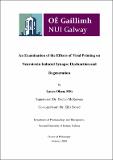An examination of the effects of viral priming on neurotoxin induced synapse dysfunction and degeneration

View/
Date
2018-10-19Author
Olsen, Laura
Metadata
Show full item recordUsage
This item's downloads: 121 (view details)
Abstract
Over 200 years since its first description, Parkinson’s disease (PD) remains the second most common neurodegenerative disorder. Treatments are insufficient and there is still no cure. The continued lack of treatment development is largely due to a lack of understanding of how the disease occurs. Current research suggests that PD develops as a result of an interaction between genes and the environment. Among the environmental factors linked with PD, certain viral infections have been found to be associated with PD. Although this epidemiological association has been documented since the 1970s, limited pre-clinical research has been conducted to investigate the neurological consequences of viral infections and if there is a pathological contribution to PD development. Due to this gap in the literature, we sought to examine the molecular and cellular consequences of viral-mediated inflammation in the context of PD pathology.
This study aimed to investigate the potential influence viral infections might have on the neurodegenerative effects of relevant stimuli using cellular and animal models of PD. Specifically, synthetic viral-like dsRNA (poly I:C) was used to induce an innate immune response in a human SHSY5Y cell line, E14 rat ventral mesencephalic (VM) primary cultures and in an in vivo Sprague-Dawley rat model. This viral-like priming was followed by a subsequent neurotoxin treatment of 6-OHDA, rotenone, MPP+, or FN075 (pre-clinical models of PD). In general, poly I:C priming, in combination with stimuli (such as oxidative stress, mitochondrial dysfunction, or α-synuclein aggregation) used for modelling PD, resulted in the exacerbation of neurotoxin-induced degeneration. In cell culture, synapse related proteins (such as synaptophysin and PSD-95) and autophagy related proteins (such as LC3-a/b-I/II and p62) were altered due to poly I:C priming. In vivo, poly I:C priming (in combination with FN075-induced α-synuclein aggregation) in the rat substantia nigra resulted in exacerbated neuroinflammation (as measured by microgliosis and astrogliosis), motor deficits, and significant dopaminergic cell loss.
The implications of these findings suggest that viral-mediated inflammation may induce significant changes in cell death, autophagy, and synaptic related proteins in neurons. These viral-mediated molecular and cellular alterations might contribute to PD pathology, supporting the epidemiological role of viral infections in PD. Based on these findings, further investigation is needed into how viral infections might induce these changes to identify novel targets for PD treatment and/or prevention.

